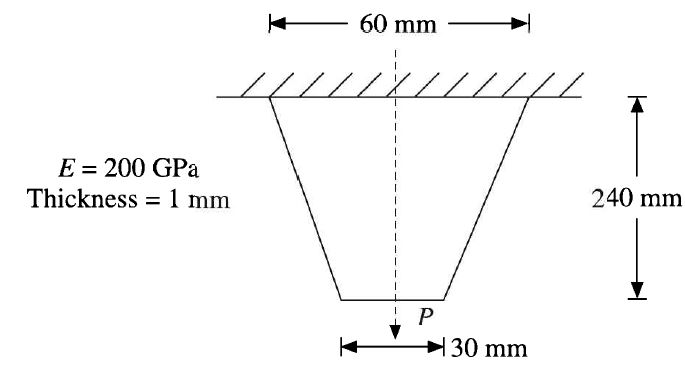Question 24.8: Consider a steel plate (E = 200 GPa) as shown in the figure.......
Consider a steel plate (E = 200 GPa) as shown in the figure. A point force is applied at the free end. (a) Model the plate with two finite elements. (b) Determine the stiffness
matrix and evaluate stress at each element.

Learn more on how do we answer questions.
Consider two elements each of length 120 mm. The finite element model, node number
and average area of each element are shown below.
The width \mathrm{d}_2 at node 2 is obtained as
=(60+30) \times \frac{120}{240}=45 \mathrm{~mm}
Hence the average area of element 1
A_1=\left(\frac{60+45}{2}\right) \times 1=52.5 \mathrm{~mm}^2 (Note that unit thickness is considered)
Similarly, the average area of element 2 is
A_2=\left(\frac{45+30}{2}\right) \times 1=37.5 \mathrm{~mm}^2
The element stiffness matrix for element 1 is
k^{(1)}=\frac{E A}{L}\left[\begin{array}{rr}1 & -1 \\-1 & 1\end{array}\right]

![]()
The stiffness matrix of the structure also known as global stiffness matrix is

=2 \times 10^5\left[\begin{array}{ccc}0.4375 & -0.4375 & 0 \\-0.4375 & 0.75 & -0.3125 \\0 & -0.3125 & 0.3125\end{array}\right]
Neglecting the weight of the structure, the force vector due to externally applied load P is
F=\left\{\begin{array}{c}F_1 \\F_2 \\P\end{array}\right\}
∴ If u_1, u_2 \text { and } u_3 are the displacements at 1, 2 and 3 nodes respectively, the equilibrium equation is
2 \times 10^5\left[\begin{array}{ccc}0.4375 & -0.4375 & 0 \\-0.4375 & 0.750 & -0.3125 \\0 & -0.3125 & 0.3125\end{array}\right]\left\{\begin{array}{l}u_1 \\u_2 \\u_3\end{array}\right\}=\left\{\begin{array}{l}F_1 \\F_2 \\P\end{array}\right\}
Now using the boundary conditions, we can determine the deformation matrix {u}. One of the boundary conditions is u_1=0 displacement at node 1 is zero. The associated force with this node is F_1. So using the partition as below
2 \times 10^5\left[\begin{array}{c:cc}0.4375 & -0.4375 & 0 \\\hdashline-0.4375 & 0.750 & -0.3125 \\0 & -0.3125 & 0.3125\end{array}\right]\left\{\begin{array}{c}u_1=0 \\\hdashline u_2 \\u_3\end{array}\right\}=\left\{\begin{array}{c}F_1 \\\hdashline F_2 \\P\end{array}\right\}
F_1=2 \times 10^5\left(0.4375 u_1-0.4375 u_2\right)
and the remaining equations are,
\left[\begin{array}{c}F_2 \\P\end{array}\right]=\left[\begin{array}{cc}0.750 & -0.3125 \\-0.3125 & 0.3125\end{array}\right]\left\{\begin{array}{l}u_2 \\u_3\end{array}\right\} (24.5)
Solving Eq. (24.5) for \left[\begin{array}{ll}u_2 & u_3\end{array}\right]^T by determining the inverse of the reduced modified 2 x 2 stiffness matrix, we get
\left\{\begin{array}{l}u_2 \\u_3\end{array}\right\}=\frac{1}{2 \times 10^5}\left[\begin{array}{cc}0.750 & -0.3125 \\-0.3125 & 0.3125\end{array}\right]^{-1}\left\{\begin{array}{c}F_2 \\P\end{array}\right\}
\left\{\begin{array}{l}u_2 \\u_3\end{array}\right\}=\frac{1}{2 \times 10^5}\left[\begin{array}{ll}2.2599 & 2.299 \\2.2599 & 5.4599\end{array}\right]\left\{\begin{array}{c}0 \\20 \times 10^3\end{array}\right\}
Solving, we get
u_2=\frac{2.2599 \times 20 \times 10^3}{2 \times 10^5}=0.22599 \mathrm{~mm}
u_3=\frac{5.4599 \times 20 \times 10^3}{2 \times 10^5}=0.54599 \mathrm{~mm}
From the elementary concept of strength of materials, the total deformation at the free end can be obtained from
u_3=\frac{P l}{\left(b_2-b_1\right) t E} \log _e\left(\frac{b_2}{b_1}\right)
Substituting b_1=30 \mathrm{~mm}, b_2=60 \mathrm{~mm}, t=1 \mathrm{~mm}, E=200 ~\mathrm{GPa}, l=240 \mathrm{~mm} \text { and } P=20 \times 10^3 \mathrm{~N}.
u_3=\frac{200 \times 10^3 \times 240}{(60-30) \times 1 \times 200 \times 10^3} \log _e\left(\frac{60}{30}\right)=0.5545 \mathrm{~mm}
The improvement in the value obtained by FEM can be possible by increasing the number of elements or by taking the higher order elements such as surface elements.
